How destructive would a failure of deterrence be?
There are two primary failure modes of deterrence: a partial one that results in either a nuclear terrorist attack or a limited nuclear war, and a complete failure that results in full-scale nuclear war. Even a small partial failure would be horrific:A 10-kiloton bomb [less than one-tenth the power of many of today's warheads] detonated at Grand Central Station on a typical work day would likely kill some half a million people, and inflict over a trillion dollars in direct economic damage. America and its way of life would be changed forever. [Bunn 2003, pages viii-ix]
There's an online tool that lets you see the effects of a nuclear blast on the location of your choice. Input an address, a city or a zip code, and it draws circles indicating the extent of blast damage. You can also vary the explosive yield. The map comes up with 100 kilotons as the default, which is the approximate yield of many of today's warheads. Change to 10 kilotons to see the effect of a Hiroshima type explosion, which is also what terrorists will inflict if they get about 100 pounds of HEU (highly enriched uranium). The video below runs less than a minute and shows the effects of nuclear tests on various structures.
A complete failure of deterrence is almost beyond imagination and conjures up mythic analogies. In a 1961 speech to a Joint Session of the Philippine Congress, General Douglas MacArthur, stated, "Global war has become a Frankenstein to destroy both sides. … If you lose, you are annihilated. If you win, you stand only to lose. No longer does it possess even the chance of the winner of a duel. It contains now only the germs of double suicide."
In 1986, former Secretary of Defense Robert McNamara expressed a similar view: "If deterrence fails and conflict develops, the present U.S. and NATO strategy carries with it a high risk that Western civilization will be destroyed” [McNamara 1986, page 6]. In January 2007, George Shultz, William Perry, Henry Kissinger and Sam Nunn echoed those concerns when they quoted President Reagan’s belief that nuclear weapons were "totally irrational, totally inhumane, good for nothing but killing, possibly destructive of life on earth and civilization." [Shultz 2007]
DoD and related studies, while couched in less emotional terms, still convey the horrendous toll that a full-scale nuclear war would exact: "The resulting deaths would be far beyond any precedent. Executive branch calculations show a range of U.S. deaths from 35 to 77 percent (i.e., from 79 million to 160 million dead) … a change in targeting could kill somewhere between 20 million and 30 million additional people on each side ... These calculations reflect only deaths during the first 30 days. Additional millions would be injured, and many would eventually die from lack of adequate medical care … millions of people might starve or freeze during the following winter, but it is not possible to estimate how many. … further millions … might eventually die of latent radiation effects." [OTA 1979, page 8]
The same 1979 OTA report also noted the possibility of serious ecological damage [OTA 1979, page 9], a concern that assumed a new potentiality when the "TTAPS Report" [TTAPS 1983] noted that the ash and dust from so many nearly simultaneous nuclear explosions and their resultant firestorms might usher in a "nuclear winter" that could erase homo sapiens from the face of the earth, much as many scientists now believe the dinosaurs were wiped out by an "impact winter" caused by ash and dust from an asteroid impacting the Earth 65 million years ago.
The TTAPS report produced a heated debate, and there is still no scientific consensus on whether a nuclear winter would follow a full-scale nuclear war. Recent work [Robock 2007, Toon 2007] suggests that even a limited nuclear exchange, or one between newer nuclear weapons states, such as India and Pakistan, could have devastating long-lasting climatic consequences due to the large volumes of smoke that would be generated by fires in modern megacities.
In a full-scale nuclear war civilization would almost surely be destroyed, and there a reasonable possibility that no human beings would survive.
References:
[Bunn 2003]: Matthew Bunn, Anthony Wier, and John P. Holdren, Controlling Nuclear Warheads and Materials: A Report Card and Action Plan, Project on Managing the Atom, Belfer Center for Science and International Affairs, John F. Kennedy School of Government, Harvard University, 2003. Accessible online.
[McNamara 1986]: Robert S. McNamara, Blundering Into Disaster, Pantheon Books, New York, 1986.
[OTA 1979]: Office of Technology Assessment, "The Effects of Nuclear War," May 1979. Available from NTIS, order #PB-296946. Also accessible online.
[Robock 2007]: A. Robock, L. Oman, G. L. Stenchikov, O. B. Toon, C. Bardeen, and R. P. Turco, "Climatic consequences of regional nuclear conflicts," Atmos. Chem. Phys., 7, 2003-2012, 2007. The paper and a discussion are accessible online.
[Shultz 2007]: George Shultz, William Perry, Henry Kissinger, and Sam Nunn, "A World Free of Nuclear Weapons," The Wall Street Journal, January 4, 2007, Page A15. Accessible online.
[Toon 2007]: O. B. Toon, R. P. Turco, A. Robock, C. Bardeen, L. Oman, and G. L. Stenchikov, "Atmospheric effects and societal consequences of regional scale nuclear conflicts and acts of individual nuclear terrorism," Atmos. Chem. Phys., 7, 1973-2002, 2007. Accessible online.
[TTAPS 1983]: Turco, R.P., Toon, A.B., Ackerman, T.P., Pollack, J.B., and Sagan, C., "Nuclear Winter: Global Atmospheric Consequences of Nuclear War," Science, vol. 222, 1983.



